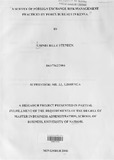| dc.description.abstract | This research endeavored to achieve two main objectives: to ascertain the foreign
exchange risk exposures faced by forex bureaus in Kenya and to determine the foreign
exchange risk management practices they use to mitigate the foreign exchange risks.
Empirical evidence was extensively used to link the findings of the study with
prescriptions of academic literature.
The research was an exploratory study carried out as a sample survey. The study focused
on a sample size of seventy-five forex bureaus out of a population size of ninety-four in
Kenya. Only fifty-three forex bureaus responded representing seventy one percent of the
sample size study population. Qualitative primary data was used for the study. Selfadministered
questionnaires were administered to the treasury departments/ financial
managers of the forex bureaus using' drop and pick later' technique. Descriptive statistics
were used to analyze the data.
Transactions that exposed forex bureaus to foreign exchange risks were; buying and
selling of foreign currencies, cross currency dealings and investing and financing in
foreign currencies. The United States dollar, the Sterling pound and the Euro were
currencies that were greatly traded and thus had the greatest contribution to foreign
exchange risk.
Forex bureaus indicated to face Transaction, Economic and Accounting exposure.
Transaction exposure was rated as the most critical compared to the other two form of
exposures. Other foreign exchange risks included; forecast risks, market structure, money
laundry and currency fraud. Market measures of foreign exchange risks were bench
marking, price determination, foreign exchange fluctuations, weekly exposure reports and
transaction, economic and accounting exposure concepts. The foreign exchange risk
management practices they used to mitigate foreign exchange risk emanating from
foreign exchange dealings were; use of forward contracts (most frequently used financial
instrument), money market hedge, currency swap, currency option, use of fake currency
detector, currency scanning machine, dealing with well known customers and holding
III
adequate resources in terms of foreign currency assets and liabilities. Hedging strategies
used include; diversification, matching and risk sharing. Regular and systematic appraisal
of foreign exchange risk management policies was a common practice amongst most of
them. Most forex bureaus indicated that their foreign exchange risk management systems
were governed by guidelines set by the central bank of Kenya as well as their individual
decisions as cases demanded.
The findings from most forex bureaus were similar to empirical evidence but
considerably inconsistent with recommendations of academic literature. Forex bureaus,
regardless of their size, extensively utilized most of the conventional hedging
instruments. | en |

